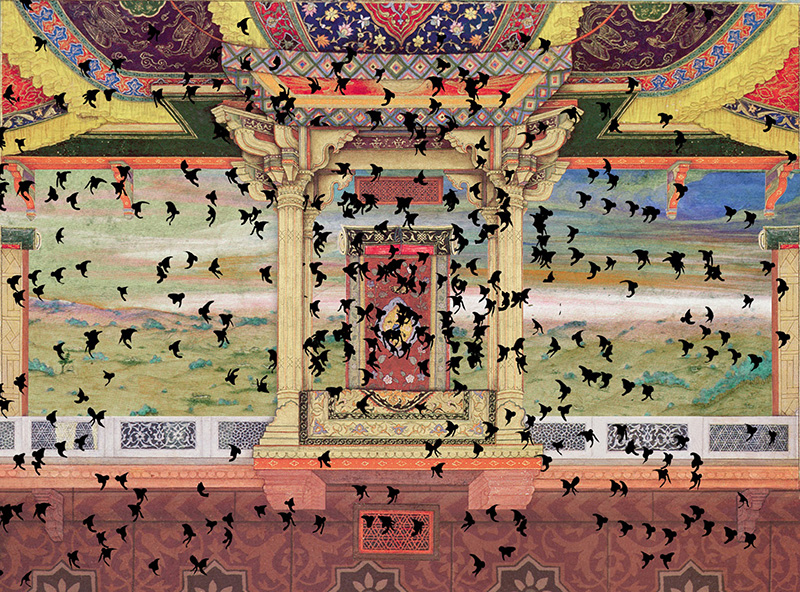The Pakistani-American artist currently has a groundbreaking feminist public installation on display in New York
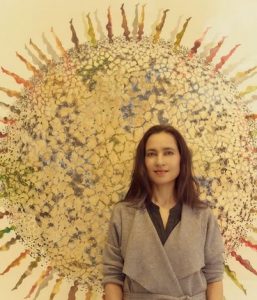
While the miniature is a long-standing motif of her formidable oeuvre, there is certainly nothing minuscule about the stature of acclaimed Pakistani-American visual artist Shahzia Sikander in the art world.
In fact, the 54-year-old’s most recent public project could definitely be described as impactfully larger than life, and is currently on display till early June 2023 at the Appellate Courthouse & Madison Square Park in New York City, USA (where Sikander lives and works). Under the title Witness (2023), her work has been described by The Brooklyn Rail as “a resplendent, golden female figure confidently holding court from within a fenced lawn… impossible to miss. At three times the size of the average person, it is one of two sculptures that make up MSP’s timely new installation, ‘Havah…to breathe, air, life’, which focuses on justice, and the empowerment of women.”
The “distinctive feminist-driven iconography” of both sculptures is undoubtedly fascinating. In “Havah…”, a human-nature hybrid of sorts sings a paean to the planet, and concepts of nurturing and power (havan in Urdu means “air” or “atmosphere” and “Eve” in Arabic and Hebrew). In ‘NOW (2023)’, after a row of male figures (Confucius, Moses, etc), Sikander’s is the first woman of color. In this regard, Sikander has also referred to the late Ruth Bader Ginsburg as inspiration — the second woman to sit on the US Supreme Court and a trailblazer recently lost to the world. Incidentally, the latter came into controversy when more conservative onlookers described its ram horn-like hair structure (which critics denote as a symbol of power) to be ‘satanic’.
View this post on Instagram
Outside of the brouhaha, however, this latest installation gives a little glimpse into the process and journey of the artist Sikander, who has for decades now sought to subtly dismantle patriarchal and colonial narratives while “pushing beyond the bounds of geography, nationality, and identity”, writes The New Yorker. Attributing the remaking of the art of miniature painting to Sikandar’s delightfully disruptive vision, the magazine adds, “Sikander’s work (has) signalled to a new generation of artists that a once marginalized form could be turned to fresh and interrogating ends.”
It has been written that “Sikander combines elements of the antique art form with contemporary concerns”.
The world of her neo-miniatures is indeed enthralling. Take for instance The New Yorker’s breakdown of her painting, ‘Prey’. It writes: “Sikander plays with the imagery of a woodland hunt, a common scene in Persian paintings. What originally appears to be a God’s-eye view of a lush, teeming forest turns out to be an aerial perspective of war. Shadows of fighter jets replace the traditional human hunter of the genre, imbuing it with a modern perspective, and darkly changing the nature of the hunt itself.”
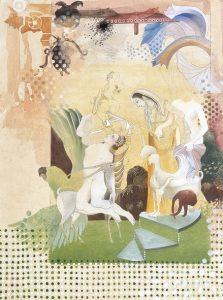
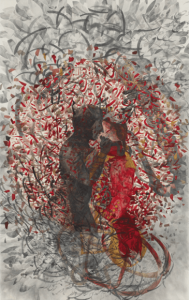
Sikander was born in 1969, in Lahore, Pakistan. She studied at The National College of Arts in Lahore, where she was taught the traditional discipline of Indo-Persian miniature painting, which often integrates traditional forms of Mughal (Islamic) and Rajput (Hindu) styles and culture. After a Bachelor of Fine Arts in 1991, her groundbreaking work circa 1989-1992, The Scroll, has come to be called the neo-miniature. NPR.org chronicles that here: “Sikander’s attention to small detail, muted color palettes, and understanding of architectural elements juxtaposed with the intimacies of domestic culture… Common concerns of economics, imperialism, colonialism, sexualism and identity are also apparent in Sikander’s early paintings.”
Later, she moved to the US and attended the Rhode Island School of Design (RISD), earning a Master of Fine Arts in Painting and Printmaking in 1995. Then, till 1997, she participated in the CORE Program of the Glassell School of Art at The Museum of Fine Arts, Houston.
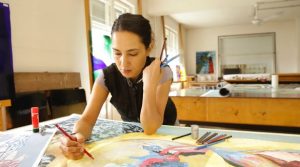
Today, she works across a variety of mediums, including drawing, painting, printmaking, animation, installation, performance and video.
Sikander’s vibrant multimedia practice coalesces seamlessly with the socio-politico-cultural facets she so instinctively explores. For instance, as a female Muslim artist, Sikander has also cast perspective on a wholly personal aspect of identity politics. According to one report: “In a performance piece, Sikander wore an elaborate lace veil for several weeks while documenting the reaction of her peers. She explains that the veil gave her an ultimate sense of security, stating that, ‘It was wonderful to not have people see my facial or body language, and at the same time be in control and know that they did not know I was acting, and checking their reaction.'” Elsewhere, “‘SpiNN’ is an animation whose title references CNN and the media’s power in shaping narratives, depicts a Mughal durbar, an imperial hall usually occupied by men and a regular subject of manuscript paintings.”
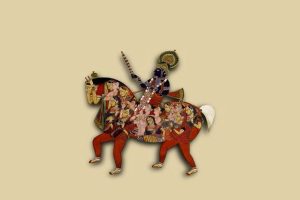
Over the years, Artsy notes that Sikander has “exhibited in New York, London, Berlin, Rome, Miami, Lahore, and Tokyo. Her work has sold for six figures at auction and belongs in the collections of the Hirshhorn Museum and Sculpture Garden, the Metropolitan Museum of Art, the Museum of Modern Art, the Sharjah Art Foundation, the Guggenheim Museum, and the Whitney Museum of American Art”.

